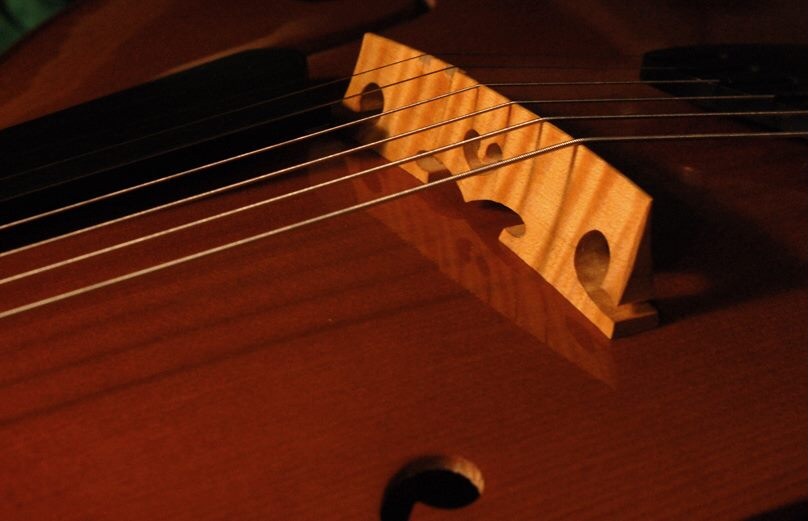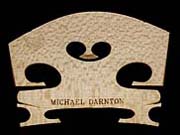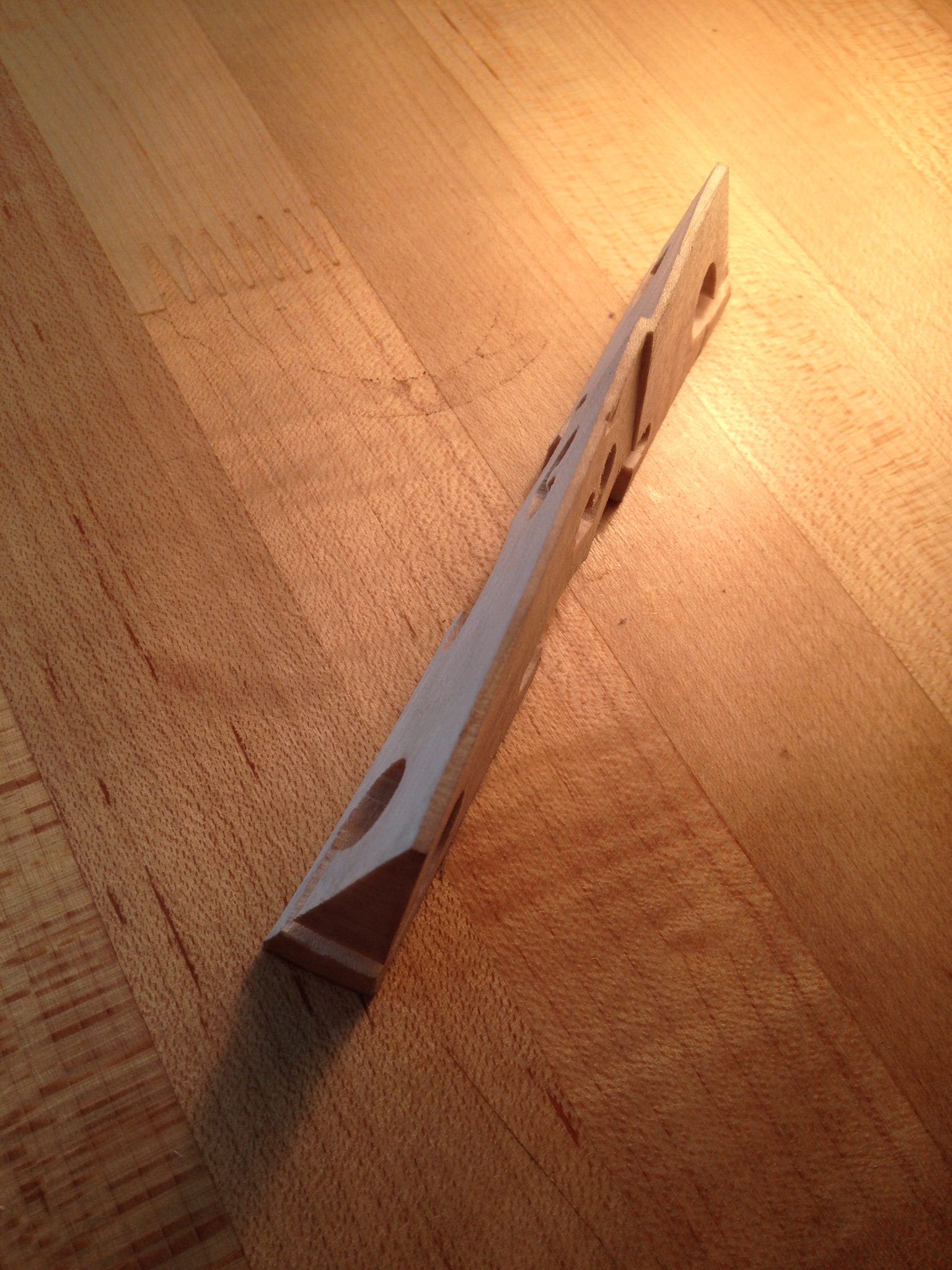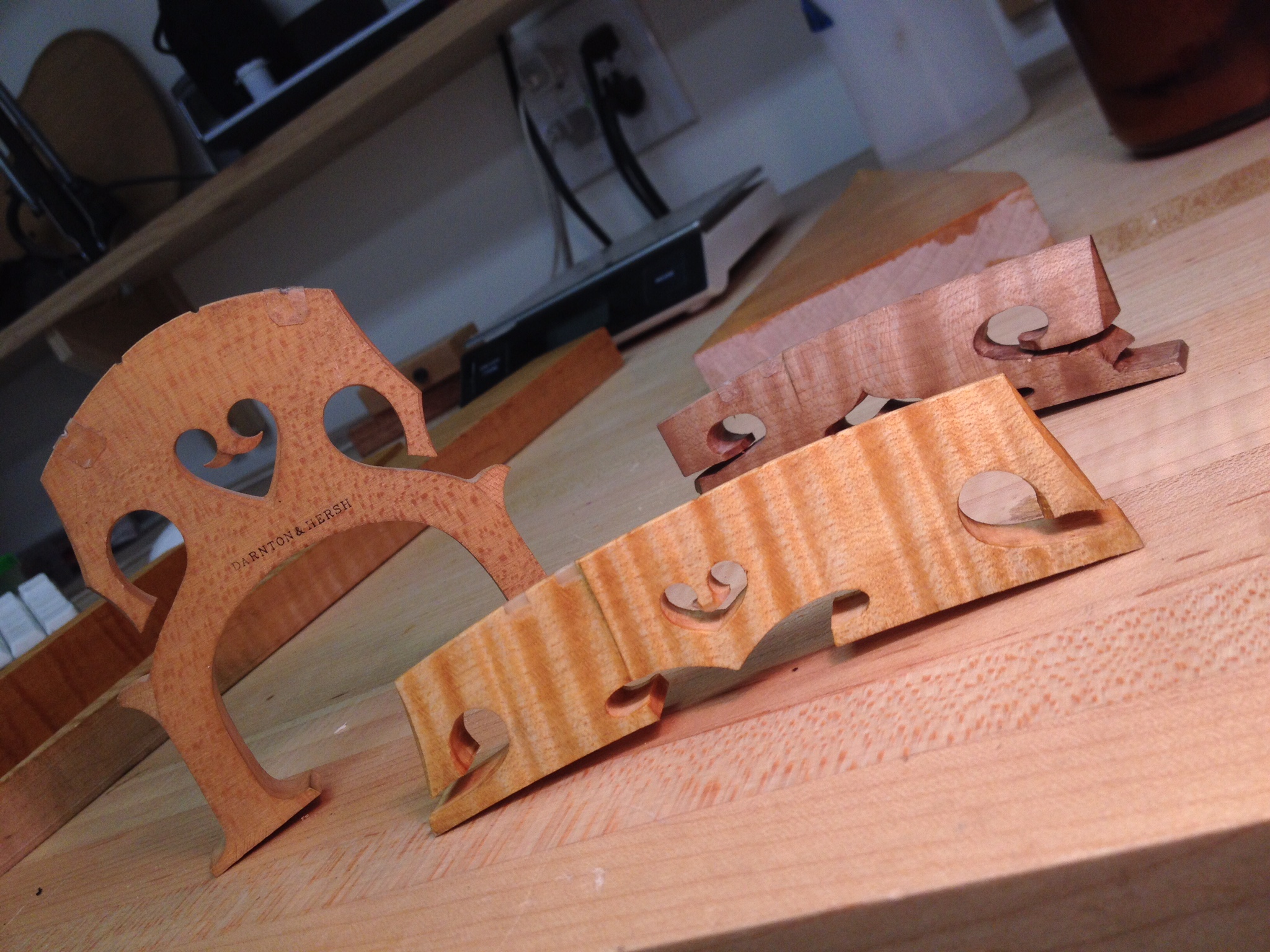The Birth of a New Amati Bridge
Guitar makers I admire are always thinking about new ideas and trying them out. Even if you land on a good idea, you think of why it’s good and if it can get any better.
A guitar bridge is a specific component, made to do a simple task of putting as much string energy into the guitar. It’s a place that one can see the flavors of the maker’s ideas. It is an area that I always think about, especially on the Amati carved bridge.
I was working on a client owned Amati recently and I decided to refine the carved bridge. The guitar came in for a few adjustments. After a year or so the guitar flexed enough to put a little too much space under the strings, a normal and simple adjustment to do on most any guitar. On an adjustable bridge one would simply lower the saddle and adjust the neck. However, the Amati bridge is like a cello bridge, the action or string height must be cut down.
Bridge design is a very important element of the success of an instrument. A bridge must fit perfectly to the surface of the top like it was born there. I believe a bridge needs to be flexible while remaining dense. A bridge is the connection between the strings energy and the 5% of audible energy that one actually hears. As a maker, choosing the right design is a balance of form and function while still putting your own unique stamp on it. It is fascinating to look at the work of different makers to see how they have manipulated bridge design.
While I was working at Darnton and Hersh: Fine Violins, our work centered on the restoration and setup of violins, cellos and violas. Instruments would come into the shop that had been setup by other instrument makers including their hand cut bridges. My mentor, Michael Darnton and I would discuss why a bridge design was failing at captivating the true essence and vibrancy of a particular instrument. It is hard to put into words the right way to carve a bridge but in a nutshell, simple, graceful shapes with purpose are the center of every cutting decision. Smart curves provide strength and beauty while leaving behind only enough material that needs to be there. One of the best conversations I had with Michael, while I was working for him, was talking about shrinking ourselves down and riding the lines of a violin bridge in a small roller coaster cart. That night I had a dream I was swishing and swooshing in a small cart all over a violin bridge. Within a day my bridge work improved.
I had designed the previous Amati bridge from a picture of one of Stradivari’s surviving bridges. This bridge is beautifully proportioned with strong shapes and purpose. The relationship to the height and size of the bridge to that of the guitar bridge is slightly different so I scaled the bridge accordingly trying to respect its origin as best as possible. The biggest challenge making this bridge design work on a guitar was to build in compensation, meaning it needed to be twisted along its length.
Lowering this bridge brought out some interesting observations. The lower bridge obviously became more stable. Some of the airiness and vibrancy was lost. It still sounded great but it was much quicker to decay. We put heavier .013 strings on to see what would happen. The guitar changed with a powerful voice, perfect for a rhythm instrument, but Amati owner and I were still after the sweet harp-like openness it had before. I knew I needed to rethink the bridge.
The biggest issue was the height of the bridge. A shorter bridge will always be more stable than a taller one. A step stool is always more stable than a 12 foot ladder! In bridge language, the more stable it is, the less rocking motion it will have which in turn affects the treble and mid range vibrations of the top. Bass will be least affected because it’s movement is more vertical to the vector forces of the strings but depending on the string angle change it can be affected to. With so many factors going on, one can see that bridge design needs to be a delicate balance tailored specifically to each instrument.
My solution stayed within the world of string instruments as I revisited my work on cellos. The current bridge, after it was shortened for proper action, was no longer in balance. The client was quick to hear the difference. The new bridge needed a more direct path to the soundbox as well as a more flexible profile. I want the energy to go right from the string to the air being pushed out of the box.
The new bridge lowered the action to the correct height while bringing out the clarity, balance, and shimmering qualities that we loved about this Amati. This experience was a learning opportunity for me and I was pleased that my initial work on the original bridge was an eye opener. That adjustment led to the new design which I feel is an all around better bridge. The bridge work on the Amati is very rewarding because it provides immediate feedback on just how versatile and specific the archtop guitar can be.
Not only is it a more beautiful solution, the client of this Amati now has multiple bridges that allow for completely different voices and styles of play.
Tags: archtop, archtop bridge, bridge, Guitar, hand carved





do you make the amati maple bridge for guitar for sale
Hi Matt, I do not supply the Amati bridge because each bridge is cut very specifically to each guitar. I would feel bad selling bridges that had my name on them and fit incorrectly on a different instrument. Thanks for your inquiry. -Danny
So fascinating! Was the cello inspired bridge lighter as well?
Yes, Much, much lighter. I haven’t measured them but they are probably 25% or less of the standard ebony adjustable bridges. It also helps to use really old dried up maple.